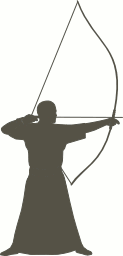Process
|
Kyūdō is the Japanese art of archery. It bears the thought that an optimal result follows from an optimal process. |
A formal design process helps you by slicing a possibly huge, overwhelming task into several smaller, manageable ones. It offers common ground for collaboration. Gathering and separating facts and assumptions provides you with the best possible base to make decisions. Building tight requirements restricts the otherwise infinite space of possibilities in design and make sure you will not get lost in randomness.
The design process can be linear, but each step might reveal problems with an earlier step; you should revisit it, then. The process becomes iterative.
There are varying models and descriptions of design processes, but the basics tend to stay the same.
Briefing
The very first step in a design process should be the description of the problem to solve, or the task to accomplish. Think about whether you are getting at solving the right problem, or if you merely deal with symptoms of something else. Try to capture the essence of it in a single sentence and follow up with definitions all terms you used that might be unclear.
State your goals (think of measures of your success). Prioritize or organize them in a hierarchy if possible.
List constraints. Build a schedule.
As the insight grows while the project proceeds, it might be necessary to revisit this briefing and start over.
Analysis
This step is sometimes indiscernible from either Briefing or Research.
- Accept only that as fact which you are sure of.
- Only make the assumptions you need and state them as such.
- Break your problem down into smaller parts.
- Identify obstacles
Research
Collect relevant information. The depth depends on how much time you have or want to spend here. You shouldn't get carried away, but ignorance is limiting.
Try to find out or define:
- what are, and have been, the approaches and outcomes in the same or a comparable subject?
- who is your audience and what does that mean for your project?
- what is the environment or system your solution has to function in?
Make sure to draw as many relevant conclusions as you can from your material.
Specification
List all requirements to be satisfied. Break them down by field and importance.
Likely sources are:
- Project goals
- Context: the system, environment, infrastructure ...
- Audience
- Time (in the commercial field also budget)
- Expertise
- Equipment
Conception
- Develop concepts in response to your research.
- Try different angles for each aspect.
- Work on both the macro and detail levels.
- Extend your research to help in conception as needed.
Have a look at some problem-solvingtechniques (Wikipedia)
Design and Implementation
Pick one or several concepts and work from broad sketches towards detailed designs. Move from mockups to actual implementation.
Evaluation
Evaluate the result based on your goals and requirements. Repeat the process or parts of it as needed for improvement.
Artwork/Documentation/Process (last edited 2009-04-15 17:17:00 by p50896C2D)
